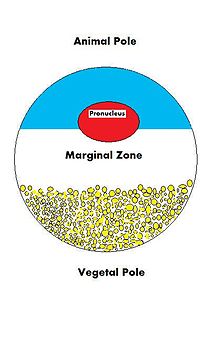Polarity in embryogenesis

In
germ layers and participating in gastrulation
.
The vegetal pole contains large yolky cells that divide very slowly, in contrast with the animal pole above it. In some cases, the vegetal pole is thought to differentiate into the
extraembryonic membranes that protect and nourish the developing embryo, such as the placenta in mammals and the chorion
in birds.
In amphibians, the development of the animal-vegetal axis occurs prior to fertilization.[1] Sperm entry can occur anywhere in the animal hemisphere.[2] The point of sperm entry defines the dorso-ventral axis - cells opposite the region of sperm entry will eventually form the dorsal portion of the body.[1][3]
In the frog embryogenesis is organized.[5]
Naming
The animal pole draws its name from its liveliness relative to the slowly developing vegetal pole, while the vegetal pole is named for its relative inactivity relative to the animal pole.
See also
- Gastrulation
- Embryogenesis
References
- ^ a b Gilbert SF. Developmental Biology. 6th edition. Sunderland (MA): Sinauer Associates; 2000. Early Amphibian Development. Available from: https://www.ncbi.nlm.nih.gov/books/NBK10113/
- ISBN 9780198709886. Retrieved 12 October 2015.
- PMID 10644406.
- ISBN 9780198709886. Retrieved 12 October 2015.
- ISBN 0387537406
